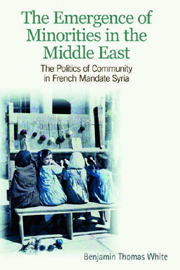Book contents
- Frontmatter
- Contents
- Map 1. Syria c.1936
- Map 2. The Far Northeast of Syria in the 1930s
- Outline Chronology of the French Mandate, 1919–39
- Acknowledgements
- Introduction
- Part I
- Part II
- 3 Separatism and Autonomism
- 4 The Border and the Kurds
- Part III
- Conclusion: Minorities, Majorities and the Writing of History
- Select Bibliography
- Index
3 - Separatism and Autonomism
from Part II
Published online by Cambridge University Press: 12 September 2012
- Frontmatter
- Contents
- Map 1. Syria c.1936
- Map 2. The Far Northeast of Syria in the 1930s
- Outline Chronology of the French Mandate, 1919–39
- Acknowledgements
- Introduction
- Part I
- Part II
- 3 Separatism and Autonomism
- 4 The Border and the Kurds
- Part III
- Conclusion: Minorities, Majorities and the Writing of History
- Select Bibliography
- Index
Summary
Introduction
The local governor was worried about ‘separatist propaganda’ in his border region, far from Damascus. Concerned about the ‘state of mind that reigns among the inhabitants’, in the spring of 1939 he sent a secret report to the interior ministry. The people of his governorate, he wrote, were ‘very close in their characteristics and customs’ to the inhabitants of the neighbouring state, a feeling reinforced by ‘their close communication with it’. In the main town, a preacher had stated that the district ‘does not recognise the [Syrian] government nor the president of the Republic’. Alarmingly, this sentiment resonated with the local population, who manifested ‘hostility towards the Syrian government and its employees, especially those who are not local people [man kān min ghayr ahālī al-mintaqa]’. The governor feared for the state's ability to control the situation, especially with a tiny police force whose men were all locals, and of suspect loyalty; and the local French colonel was keen to intervene, which would further undermine the National Bloc government's authority in the area.
Separatist mobilisations of the kind that worried this Syrian official were a common feature of life in the new nation-states of the inter-war world, though perhaps less common than exaggerated state fears about them. Both are still with us. From the Polish government's attitude to its German population in the 1920s to the Turkish Republic's fears of its Kurds today, separatism has also commonly been associated with minorities.
- Type
- Chapter
- Information
- The Emergence of Minorities in the Middle EastThe Politics of Community in French Mandate Syria, pp. 69 - 100Publisher: Edinburgh University PressPrint publication year: 2011



